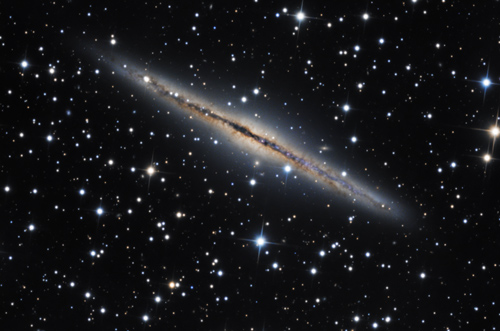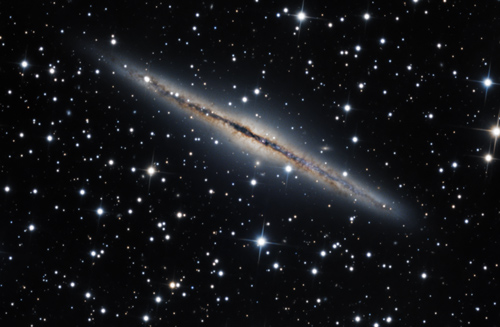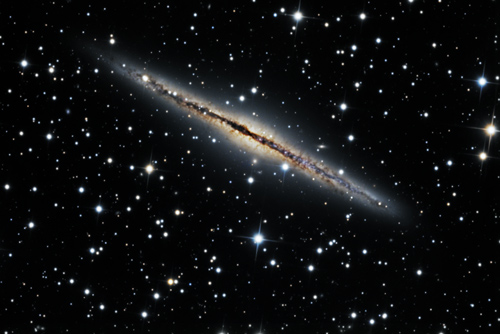|
| |
NGC891
Image Information
|
From SEDS.org
Discovered by William Herschel in 1784.
NGC 891 is a fine edge-on spiral with a faint dust lane along its
equator. It was discovered by
William
Herschel on October 6, 1784, and
cataloged as H V.19. However, in the appendix to his first catalog,
he confused it with his H V.18 (M110,
NGC 205) when discussing the
discoveries
of his sister
Caroline
Herschel, in this case her entry No. 9; this remark was picked up by
Admiral Smyth
and later authors so that it was wrongly attributed to Caroline for a
long time.
Gilbert A. Esquerdo and John C. Barentine have
investigated NGC 891
in the infrared part of the electromagnetic spectrum, and suspect that
this galaxy might have a bar (and thus be of Hubble type SBb) which is
not seen in the visible image because of its edge-on orientation.
NGC 891 is a member of a small group of galaxies, sometimes called
the NGC 1023 group, which also contains NGCs 925, 949, 959, 1003, 1023,
and 1058 as well as UGCs 1807, 1865 (DDO 19), 2014 (DDO 22), 2023 (DDO
25), 2034 (DDO 24), and 2259.
Supernova 1986J was discovered in NGC 891 by van Gorkom, Rupen,
Knapp, Gunn on August 21, 1986 and reached mag 14 (see
IAUC 4248).
NGC 891 is contained in the
SAC 110
best NGC object list. It is also
Caldwell 23 in Patrick Moore's List. In the
RASC's
Finest N.G.C. Objects Objects list.
Edge-on spiral galaxy NGC 891 was featured in Jeff Bondono's
Masterpieces Messier Missed for December, 1995
NED
data of NGC 891
SIMBAD
Data of NGC 891
Publications on NGC 891 (NASA ADS)
Observing Reports for NGC 891 (IAAC Netastrocatalog)
NGC Online
data for NGC 891
|

800
1600

1600

1600

1600
| This image is compiled from 25 - 20 minute
luminance images and 4 - 20 minute each the
RGB
binned 2x2 for a total of 12-1/3 hours. The last three
listed are with a total of 8 - 20 minute RGB
frames for total time of 16-1/3 hours. All
data was acquired using MaxImDl/CCD version 5 using ACP.
Images were calibrated and
De-Bloomed in MaxIm using Ron Wodaski's De-Bloomer plug-in. All images
aligned, averaged combined, 5 iterations of Regularized Lucy
Richardson de-convolution, and histogram adjusted at 32 bit depth
using Pix Insight version 1.61. The master images were
combined and registered in Pix Insight. Photoshop CS 5 was used to
create the web version JPGs.
|
Equipment and Location Information
| Date |
November 12 - December 10,
2010 |
| Location |
Dogwood Ridge Observatory |
| Optics |
OGS 12.5" RC |
| Mount |
Astro Physics AP1200GTO |
| Camera |
SBIG ST10XME/AO8 |
| Filters |
Baader LRGB
1.25" mounted |
| Conditions |
Temperature middle teens - mid
20s with very
moderate seeing. Transparency good to moderate. |
|
